Slacklining is an exhilarating and dynamic activity that has gained popularity among outdoor enthusiasts. At its core, slacklining involves walking on a thin, flexible line suspended between two anchor points, challenging your balance and coordination with each step. Originating from the climbing community in the 1980s, slacklining has evolved into a versatile sport in which technique and precision are key.
Whether you’re a seasoned athlete or a beginner looking for a new hobby, slacklining offers a multitude of benefits, making it a valuable sport to explore. If you’re ready to embrace a new challenge and elevate your outdoor adventures, it’s time to step onto the slackline and experience the thrill for yourself.
Mental and Physical Advantages of Slacklining
The sport of slacklining provides a wealth of physical and mental perks that make it a standout activity. Physically, slacklining is an exceptional full-body workout that primarily targets core muscles, improving stability and strength. The constant need to maintain balance activates muscles in the legs, hips, and lower back, leading to enhanced muscle tone and endurance. Additionally, the ever-changing demands of the sport foster improved synchronisation and proprioception, the body’s ability to sense its position in space, which translates to better overall athletic performance.
Mentally, slacklining is equally rewarding. The intense concentration required to stay balanced on the line enhances focus and mindfulness. Slackliners often describe a meditative state, as the need to remain present and attentive to every movement helps reduce stress and anxiety. This mental clarity extends beyond the slackline, developing cognitive functions and decision-making skills in daily life. The combination of physical exertion and mental engagement makes slacklining a holistic practice that benefits both body and mind, encouraging a healthier, more balanced lifestyle.
What to wear on slackline?
As slacklining is a sport requiring focus and balance, it is best done in comfortable apparel that allows for a full range of motion. Typical clothing items worn during slacklining are t-shirts and loose-fit pants or leggings.
When it comes to footwear, slacklining barefoot is a common practice among slackliners, as it strengthens their connection with the line and improves stability. Going barefoot allows for a natural grip and a better feel of the slackline, providing immediate feedback to the feet and helping with balance and control.
People also wonder if slacklining can also be done in Neoprene socks, footwear made from neoprene, a synthetic rubber material that is water-resistant and provides insulation. These socks are commonly used in water sports like surfing, diving, and kayaking to keep feet warm and protected in wet and cold conditions. While not specifically designed for slacklining, neoprene socks may be used for this activity, especially in damp or cold environments where additional warmth and protection are needed. They offer a good grip and flexibility, similar to barefoot shoes, making them a viable option for slacklining.
An additional alternative for slacklining footgear are Skinners, which are considered to be a sock-shoe hybrid. In an attempt to combine the optimal aspects of both a sock and a shoe, due to their provided comfort, protection and durability, Skinners can be an option for slacklining.
Best shoes on slackline are barefoot shoes
However, some slackliners prefer to wear barefoot shoes, especially when walking long distances to protect feet from friction.
Barefoot shoes are the best option for slacklining as they offer a similar level of sensory feedback while providing a layer of protection against friction or cold. Barefoot shoes are minimalist shoes that are designed to mimic the feeling of being barefoot while offering some cushioning and support, making them a popular choice for those who want the best of both worlds. Proper foot protection is incredibly vital not only during daily activities, but also in the context of sport. Wearing inappropriate footwear while doing sports of any kind can lead to excessive pain and long-term damage.
Slacklining in barefoot shoes
Even though slacklining in barefoot shoes is a fairly new concept, it is gaining popularity among athletes seeking a more natural and tactile experience. Recently, Red Bull athlete and worldwide known slackliner Jaan Roose wore barefoot footwear whilst walking the world’s longest slackline between mainland Italy and Sicily.

Usually slacklining barefoot, the three-time slackline world champion tried footgear purchased from barefoot retail store Mugavik Barefoot, a renowned retail store specialising in barefoot shoes, catering to those who seek the benefits of minimalist footwear. Mugavik Barefoot offers a diverse selection of high-quality shoes designed to promote natural foot movement, improve posture, and enhance overall comfort. The store emphasises the importance of foot health and provides shoes that mimic the experience of walking barefoot while offering protection and support.
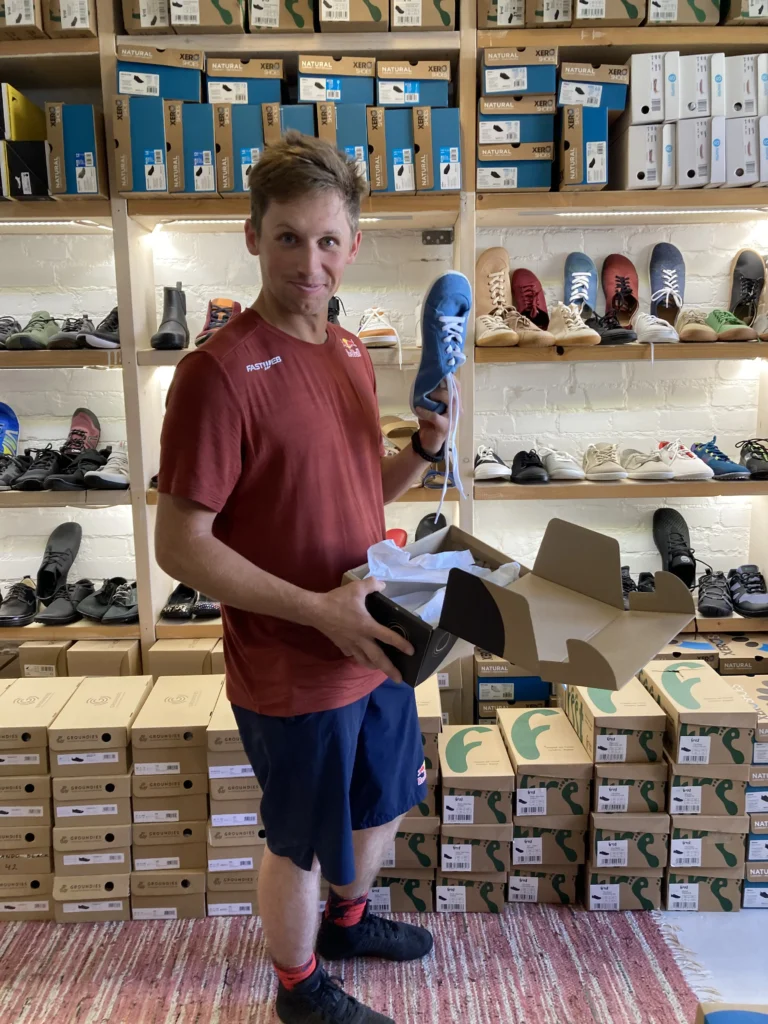
Best barefoot shoes for slacklining
When looking for the best shoes to complete his world record attempt of slacklining the 3.6 km long slackline across the Messina strait between mainland Italy and Sicily, Mugavik Barefoot offered Jaan Roose various barefoot shoe brands to consider. Jaan Roose had previously tried the Skinners for slacklining but they were not the best fit for his feet. Other slackliners have also used neoprene socks or other types of sock shoes, especially for walking long distances.
Based on the thickness, flexibility, and grip of the sole, Jaan Roose picked two models for testing:
- Leguano Go – for excellent sensory feedback of the sole
- Mukishoes Chelsea Black – for excellent sensory feedback and good grip. Also, Jaan Roose was practicing in cold conditions in Estonia at that time and thus was happy to try shoes that offered some protection from the cold weather.
After testing the shoes on the slackline in Estonia for a couple of months, Jaan Roose opted for the Mukishoes. “The grip of the soles of Mukishoes is remarkable”, says Jaan Roose.
Mukishoes soles are very thin, flexible, and made of 100% natural rubber. The latex otherwise known as natural rubber used by Mukishoes is sourced from meticulously managed rubber plantations in Guatemala. The natural rubber used by Mukishoes is inherently flexible, durable, and biodegradable.
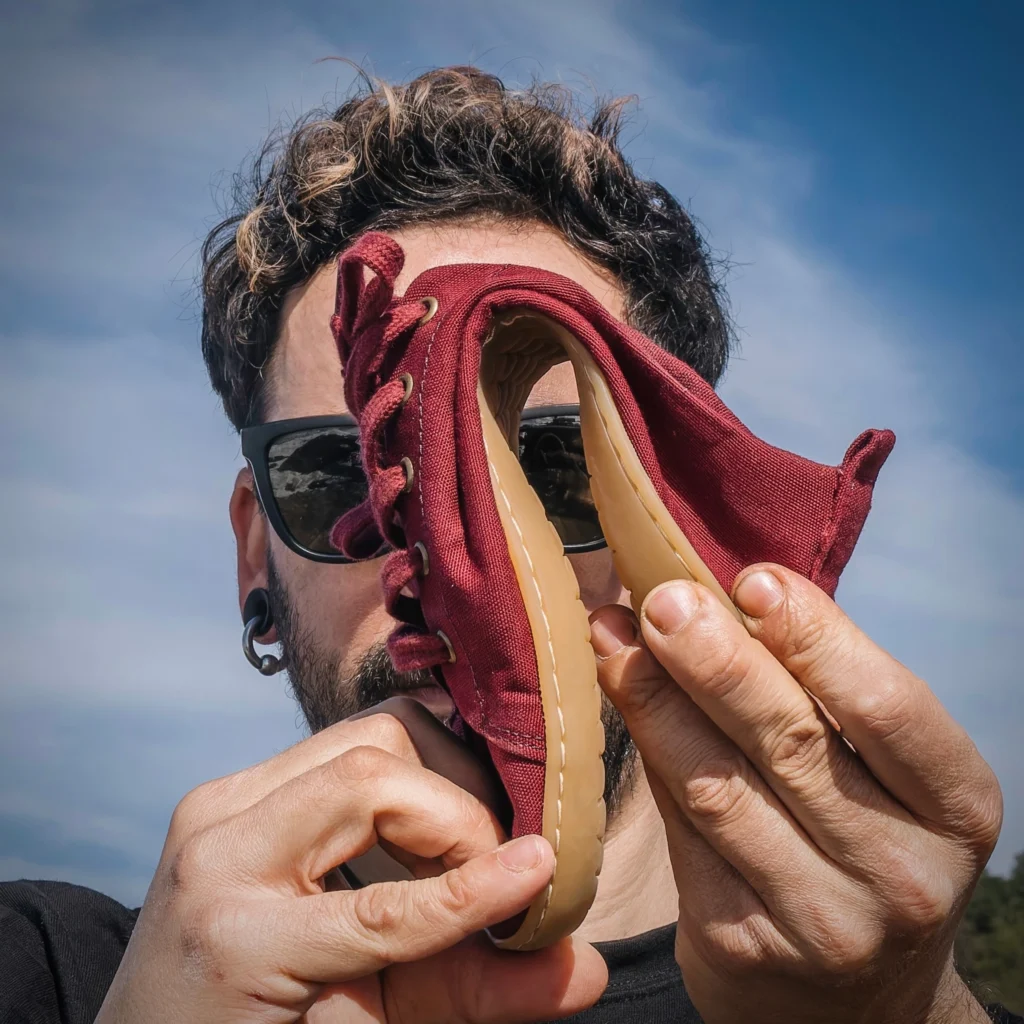
Jaan Roose finally completed his world record attempt in Italy wearing the Indigo model by Mukishoes which was better suited for the hot weather in Sicily due to the linen upper and undyed cotton lining of the model.
Roose has claimed Mukishoes trainers to be the “best shoes for walking on hitech highline (dyneema)”.
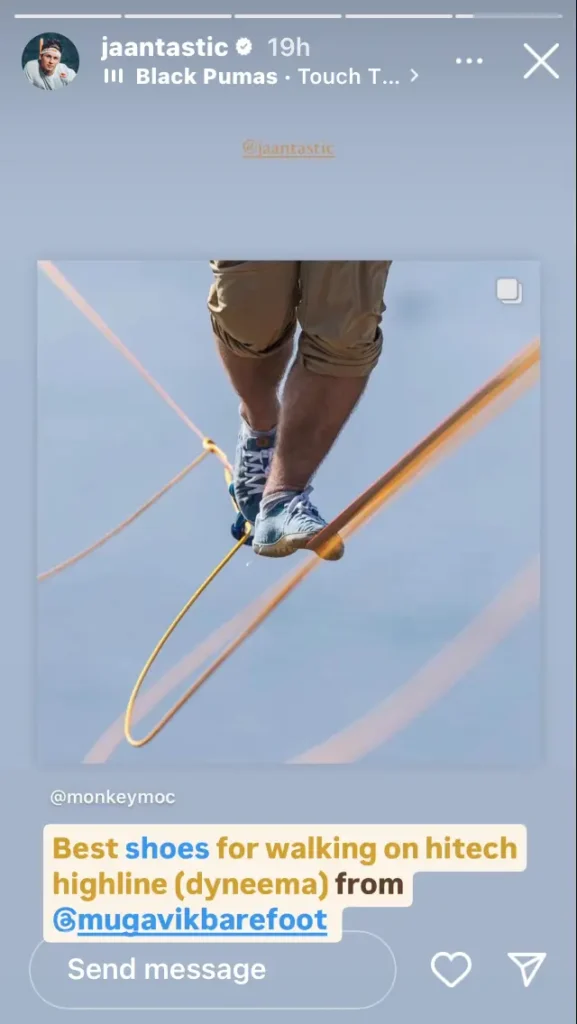
While not his first option for walking the slackline, Roose uses the Leguano barefoot shoes as everyday shoes for regular wear. He says “the sensory feedback from the ground of Leguanos is exceptional. If only the soles had a better grip, Leguanos would be great for slacklining. I do love them as everyday shoes though”.
Roose is generally very satisfied with finally finding good shoes for slacklining long distances. While he prefers to slackline barefoot, the long distances and weather conditions do not favour that always. “I’m very thankful to Mugavik Barefoot for looking me up and giving me the chance to test shoes from their great barefoot shoe selection. It’s amazing how many great shoes they have to offer. I could not have done the 3.6 km Messina strait without their support :)”.
Barefoot shoes are not just good for slacklining but for any life activity due to their flexible soles with good ground feel, wide toebox, and natural shape. If you’re interested to learn more about barefoot shoes in general, read our blog post or shop the shoes here.
A few examples of barefoot shoes from the two favourite brands of slackliner Jaan Roose:
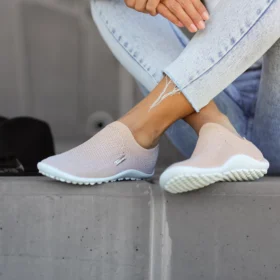
leguano scio rose
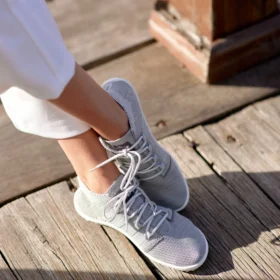
leguano beat silbergrau
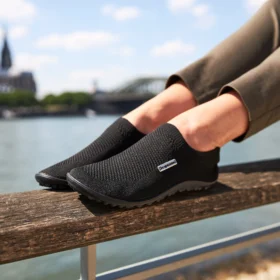
leguano scio black
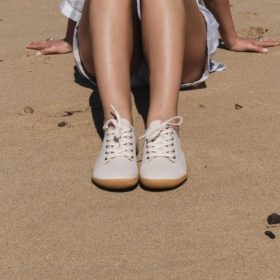
Mukishoes Sand

Mukishoes Chelsea Caramel boots
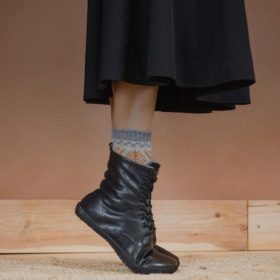
Mukishoes Igneous winter boots
How to start slacklining?
The perceived complexity of slacklining can deter some people from trying it, making the activity intimidating to beginners. People might assume that it demands a high level of skill and an immense amount of gear, however, with proper guidance, practice, and safety measures, slacklining is very much doable. Beginners should start practising on a tight slackline mounted near the ground, no higher than 20cm. As an amateur, doing simple slackline exercises can help maintain balance and harmony. Some slackline exercises include hanging push ups, one legged balanced squats, the slackline plank and slackline sit ups. When already knowing how to walk the line, holding a ball above the head whilst balancing on one foot can be a great way to practise balance.
Slackline kit
Another exceptionally important step in becoming a slackliner is familiarising yourself with the sport’s equipment. Slackliners mainly use what is called a “Slackline Kit” which consists of the following:
- Webbing: a strong, woven fabric, essentially used in the place of rope. Its flexibility, elasticity and strength make for an excellent, stable base. Webbing for slacklining comes in various materials, which should be chosen with concern to skill levels, budget and personal preference
- A frames: A Frames are required if you want to slackline without trees or posts and you don’t have other stable points at a suitable height to rig your line to.
- It is possible to buy an A-Frame pre-made or they are actually relatively easy to make from wood. Setting up a slackline without trees can be a great way to practise as a beginner.
- Slackline ratchet: a device used to tension a slackline, making it taut enough for balancing and walking. The ratchet mechanism allows you to easily and securely tighten the slackline without needing additional tools or complex setups.
- Slackline rack: Primarily designed for indoor use, the Slack Rack is ideal for situations where space is limited or when there are no stable points to secure the line and it is not possible to install ground anchors for A-Frames. The Slackline rack or stand is a completely independent and self supporting frame so no need for any other fixing equipment. Unfortunately, slackline racks are not suitable for advanced tricklining, however for mere practice and basic tricks, it can be perfect.
- Stake: anchoring tools used to secure various components of a slackline setup to the ground, especially when using A-frames or when trees or other natural anchor points are unavailable. These stakes help maintain stability and ensure the slackline remains taut and secure.
- Ground anchor: an instrument used to secure objects to the ground, providing stability and preventing movement. In the context of slacklining, ground anchors are used to hold A-frames or other slackline components firmly in place, ensuring that the setup remains secure and risk-free.
- Carabiners: specialised clips used in slackline setups to securely attach the slackline to anchor points.
- Tree protector: a heavy-duty padding only required if you are rigging your line to trees. If you are using trees as your anchor points then tree protection prevents the line from cutting into the tree bark and damaging or even killing the tree.
- Shoes
How to set up a slackline?
A question frequently asked about slacklining is how to set up a slackline. Setting up a slackline involves several key steps to ensure a safe and effective experience. First, select two sturdy anchor points, such as trees or posts, that are approximately 15 to 25 feet apart. It’s crucial to choose healthy trees with a minimum diameter of 12 inches to ensure they can handle the tension. Wrap tree protectors around the trunks at the height where the slackline will be attached, typically around waist height. These protectors prevent damage to the bark and provide extra grip for the line. Next, attach the slackline to one anchor point using a secure knot or loop, ensuring it is tightly fastened. Unroll the slackline towards the second anchor point and thread it through the ratchet mechanism. Pull the slackline to remove any initial slack before starting to ratchet. Engage the ratchet and pump the handle back and forth, gradually tightening the line until it reaches the desired tension. Be careful not to over-tighten, as this can damage the slackline or the anchor points. Once the slackline is taut, lock the ratchet in place and check the line for stability. Walk along the slackline to test the setup, making any necessary adjustments to the tension.
Can you slackline indoors?
When slacklining without trees or indoors, begin by choosing a spacious area with a flat, even surface. After gathering your equipment, position the A-frames at the desired distance and if necessary, use ground anchors or heavy weights like sandbags to secure the bases of the A-frames, especially on smooth floors. Attach the slackline by looping it around the top of one A-frame and securing it with a knot, loop, or carabiner. Thread the other end of the slackline through the ratchet mechanism attached to the second A-frame, making sure that the line is not twisted. Pull the slackline by hand to remove any initial slack, then use the ratchet handle to tension the slackline until it is taut but not over-tightened. Lock the ratchet in place to secure the line.
Slacklining stands as a dynamic pursuit cherished by devotees worldwide. It has evolved into an adaptable pastime and sport that demands balance, precision, and a keen mental focus. As interest in slacklining grows, so does the variety of equipment and footwear options, including barefoot shoes, which are gaining popularity for their natural feel and enhanced connection with the slackline. If you believe that slacklining could be an enjoyable, amusing sport for you, it might be time to embrace the art of slacklining to have a healthier, more balanced lifestyle.
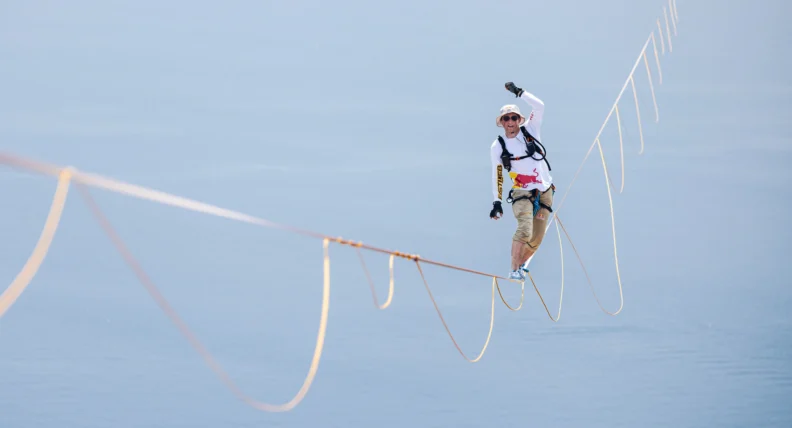


RIKA ARIYANTI –
Väga kasulik artikkel ‘Best shoes for slacklining are barefoot shoes – tested by World Champion in slacklining, Jaan Roose’. Õige jalatsite valik on slackline’i jaoks ülimalt oluline, ja see artikkel annab suurepärase ülevaate.